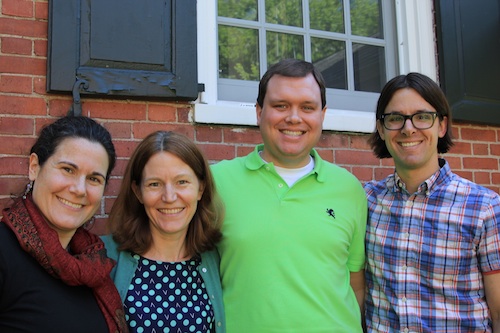
A Cross-Shaped Generation
by Kathryn McNeal
St. John’s Lutheran Church in Northfield, Minnesota, has a long and rich history beginning in 1869, when a small group of Norwegian immigrants founded the church. Over the years, the church has grown through its long-term relationship with nearby St. Olaf College, commitment to beautiful worship, and hunger for active mission and service work. The well-known St. Olaf Choir began as the St. John’s choir. Generations of renowned musicians, St. Olaf faculty and staff, and retired pastors can all be found participating in the congregational life of St. John’s. The congregation was instrumental in the formation of the Lutheran Immigration and Refugee Services, which is now an international nonprofit organization. The remarkable heritage of this congregation is clear in every aspect of its life.
Nearly 150 years after its founding, this congregation is still a vital and active force in Northfield, welcoming many people from diverse backgrounds to worship and Christian education opportunities. However, the congregation has noticed that it has undergone significant changes recently and must address these realities. Despite the presence of paid staff working with the various generations and ministries aimed to specifically reach each generation, younger generations are still noticeably less present in worship and retirees are pulled away from regular worship by grandchildren and travel, trends that is true in many churches currently. The congregation strives to serve each generation in numerous aspects, but there is limited intergenerational engagement. Though some college students worship at St. John’s along with staff and faculty members, fewer newly hired faculty and staff of St. Olaf are Lutheran, and the connection between the college and the church is not as robust as it once was. The face of who the church can serve in the community is also changing. As the population of Northfield changes over the years, so too does the mission field in which the congregation works.
Within the next several years, St. John’s will mark two important anniversaries – the 500th of Martin Luther’s posting of his 95 Theses and the 150th of St. John’s founding. As the congregation looks to its changing role in Northfield, relationship with St. Olaf, and worship demographics, the leadership team looks seriously at how these anniversaries can be best celebrated, asking, “How do we balance who we have been and who we are and who we will be as Church?” In what ways can the congregation honor its remarkable heritage and strong historical presence while still rejoicing in who the church is today? One of the ways in which the leadership team seeks to promote a sense of renewal is through its project presented at The Congregations Project.
This year’s theme, “From Generation to Generation,” encouraged a new way to look at the relationship between the past, the present, and the future. This led the team at St. John’s to view its congregation not as many generations seeking to be in ministry, to be church together, but as a single, cross-shaped generation, recognizing that there are numerous points of commonality between members, and the number of candles on a birthday cake is only one of them. To illustrate this point, the team shared a moving example of two members of the church separated by generations but brought together in shared vulnerability. Due to different medical difficulties, a young boy and an elderly woman both became reliant upon oxygen tanks at approximately the same time. The two members had not previously interacted. Yet through the shared vulnerability of needing help breathing, the two developed a relationship that stretched beyond the similar medical equipment. This point of intersection between their lives could not have been predicted by the typical sets of demographics by which ministerial lines are often drawn. Therefore, the question is raised: Where else are there points of commonality amongst the members of St. John’s that may not be immediately obvious?
As the team works to enter the new mindset of a cross-shaped generation within the church, there is a general awareness that the face of the ministry of St. John’s will not look the same as it has before. The mission remains the same. The open welcome to all only grows wider. The commitment to beautiful worship is honored as highly as ever. The rich history and valuable traditions continue to be deeply valued. However, change is inevitable. As St. John’s works to become a cross-shaped generation, the team highlights a key question: “What needs to die in us if we are to unite as one generation?” To some this may be a painful question. But as is implied in this question, death is not the end. The Lutheran theology of this congregation is quick to note that in death there is new life. In death, there is resurrection, renewal. In recognizing that which must die in the congregation to unite the congregation as one generation, new life can spring forth, and renewal can happen in the midst of the impending auspicious marks of the congregation’s historical presence in the wider Lutheran tradition and within the community of Northfield.
The anniversaries that lie ahead will be carefully negotiated and thoughtfully planned. The opportunities they present bring their own set of challenges, including temptations to nostalgia and pride. Yet through it all the congregation will continue seeking points of intersection, coming together at points of commonality, like a young boy and an elderly woman finding solace in the shared vulnerability of an oxygen tank, until the congregation is no longer a collection of generations, each being served by its own set of ministries, but a single cross-shaped generation, finding a place where every member will come together in renewed worship, mission, and ministry.